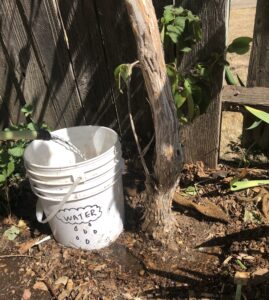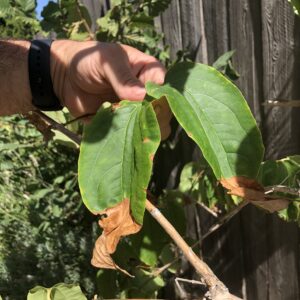Simple ways to protect your tree on windy days
The Pacific Northwest is experiencing a historic windstorm event in September, 2020. These winds can cause serious damage to both young and established trees. When the winds pick up, you can take some simple steps to prevent damage to your tree friend.
What should I do to protect my trees from wind?

Wind causes leaves to dry out more quickly. That’s why it’s important to make sure tree roots have access to water in the soil to replenish the water lost through their leaves. If trees don’t have enough access to water in the soil, the leaves can dry out, and potentially cause dieback.
- Newly planted trees (1-5 years since planting): Make sure to give young trees a nice, deep soaking of the root zone with about 10-15 gallons of water. That’s three large buckets of water, slowly added to the soil. Make sure you soak all of the soil within two feet of the trunk, and imagine you are trying to reach the roots about a foot deep in the soil.
- Established trees (5+ years): This is a great job for a soaker hose or sprinkler, slowly moistening the soil around the edge of the canopy of the tree. Some mature trees are already experiencing drought stress, so it’s extra important to give them an extra drink during windy periods.

Why does my tree lose water through its leaves?
Water loss through leaves is due to a process called transpiration, which is essentially the process that occurs after your tree takes up water from the soil, uses it for photosynthesis, and then releases it back into the air. The US Geological Survey explains it this way:
“The typical plant, including any found in a landscape, absorbs water from the soil through its roots. That water is then used for metabolic and physiologic functions. The water eventually is released to the atmosphere as vapor via the plant’s stomata — tiny, closeable, pore-like structures on the surfaces of leaves.”
That water (H2O), of course, plays an important role in photosynthesis while inside the plant, reacting with carbon dioxide (CO2) to produce some delicious sugars for the plant to eat (C6H12O6) and some complimentary fresh oxygen (O2) for us!
So, why does the wind cause tree leaves to dry out more quickly?
Because water likes to distribute itself evenly, it will tend to move from a moist location to a drier location. If the inside of the leaf is moist, and the outside air is also moist, water won’t feel the need to jump ship.
But, as Wikipedia explains, “wind blows away much of this water vapor near the leaf surface…speeding up the diffusion of water molecules into the surrounding air.” The wind moves the moisture away from the leaf, encouraging more water to exit the leaf and re-moisten the surrounding air.
So, keep an eye out for dry/windy weather in the forecast, and make sure your trees and plants are prepared. And give special attention to evergreens in windy/dry periods during the winter, as these trees with year-round leaves and needles will transpire year-round as well.
